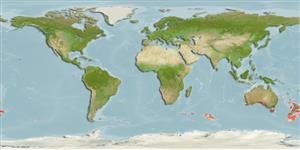>
Gadiformes (Cods) >
Macrouridae (Grenadiers or rattails)
Etymology: Coelorinchus: Greek, koilos = a hollow + Greek, rhyngchos = jaw (Ref. 45335); amydrozosterus: From the Greek amydros, indistinct, obscure, and zosteros, belt, girdle, in reference to the faint bands on the body.
More on authors: Iwamoto & Williams.
Environment: milieu / climate zone / depth range / distribution range
Écologie
marin bathydémersal; profondeur 297 - 717 m (Ref. 35909). Deep-water
Eastern Indian Ocean: southern Australia, from Western Australia to New South Wales.
Taille / Poids / Âge
Maturity: Lm ? range ? - ? cm
Max length : 25.0 cm TL mâle / non sexé; (Ref. 35909)
Épines dorsales (Total) : 2. Snout short, anterolateral margin incompletely supported by bone; orbits longer than snout and postorbital. Naked fossa of ventral light organ (ADW) relatively large, anterior end reaches about to line connecting pelvic fin insertions. Underside of head and nasal fossa naked; broad, naked, translucent areas dorsally behind leading edges of snout. A series of scales on midline of nape with median spinule row elevated into low crests, forming weak but distinct ridge from supraoccipital scute to dorsal fin. A series of 12-13 faint saddle marks, the anterior four directed anteriorly downwards. Pyloric caeca 15-16. Remarks: pelvic fin with slightly prolonged outer ray.
A benthic species found on the continental slope (Ref. 75154).
Life cycle and mating behavior
Maturité | Reproduction | Frai | Œufs | Fécondité | Larves
Iwamoto, T. and A. Williams, 1999. Grenadiers (Pisces, Gadiformes) from the continental slope of western and northwestern Australia. Proc. Calif. Acad. Sci. 51(3):105-243. (Ref. 35909)
Statut dans la liste rouge de l'IUCN (Ref. 130435: Version 2024-1)
Menace pour l'homme
Harmless
Utilisations par l'homme
Pêcheries: d'intérêt potentiel
Outils
Articles particuliers
Télécharger en XML
Sources Internet
Estimates based on models
Preferred temperature (Ref.
123201): 2.1 - 11.4, mean 9.5 °C (based on 68 cells).
Phylogenetic diversity index (Ref.
82804): PD
50 = 0.5000 [Uniqueness, from 0.5 = low to 2.0 = high].
Bayesian length-weight: a=0.00575 (0.00194 - 0.01707), b=3.08 (2.83 - 3.33), in cm total length, based on LWR estimates for this (Sub)family-body shape (Ref.
93245).
Niveau trophique (Ref.
69278): 3.5 ±0.5 se; based on size and trophs of closest relatives
Résilience (Ref.
120179): Milieu, temps minimum de doublement de population : 1,4 à 4,4 années (Preliminary K or Fecundity.).
Fishing Vulnerability (Ref.
59153): Low vulnerability (15 of 100).
